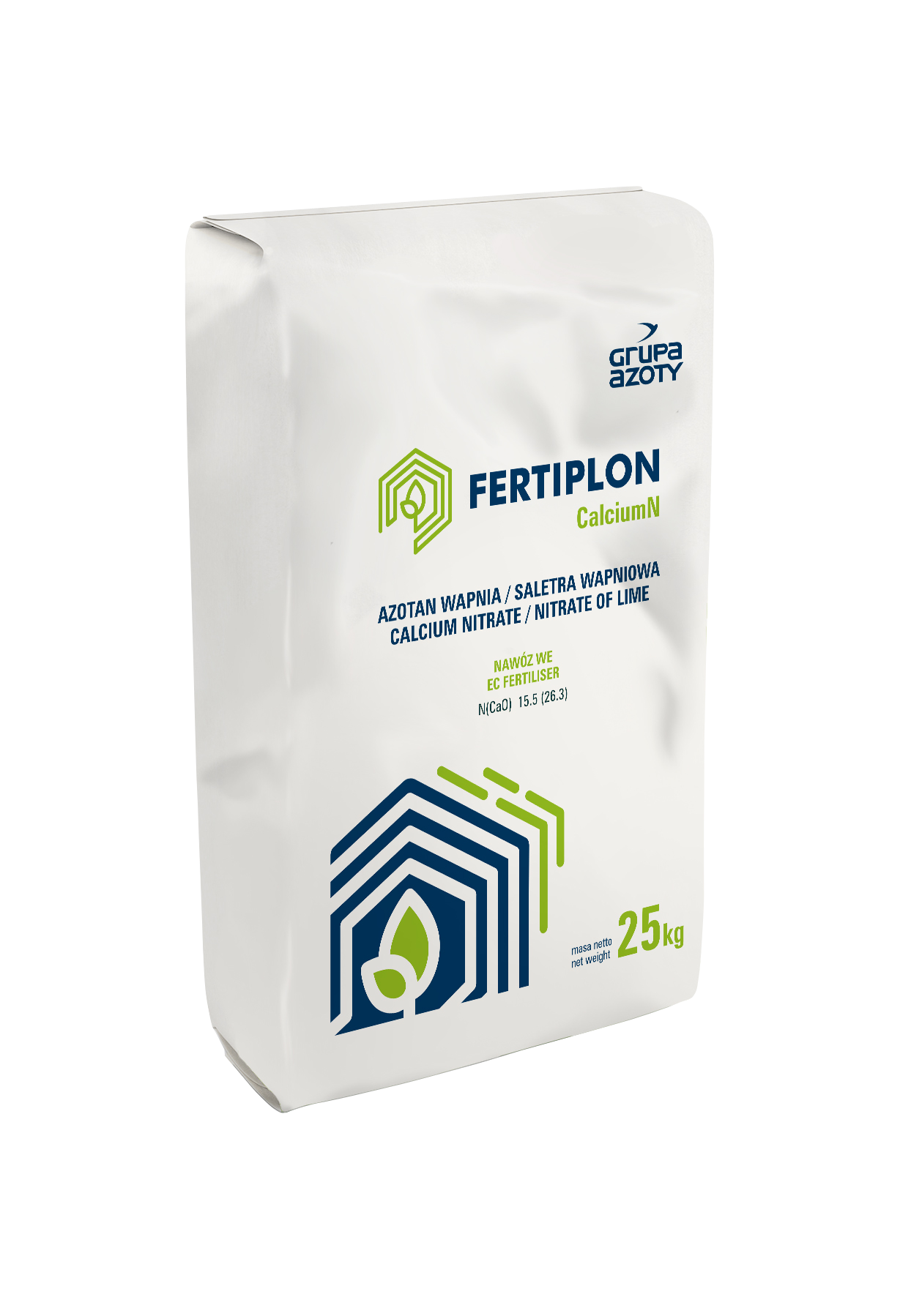
Fertiplon CalciumN Granular calcium nitrate (calcium salt-peter) is a high quality, completely soluble nitrogen-calcium fertilizer used in garening, horticulture and agriculture.
| Nutrients | % (m/m) |
| Total nitrogen (N) | At least 15.5 |
| Nitrate nitrogen (N-NO3) | At least 14.4 |
| Ammonia nitrogen (N-NH4) | 1.1-1.5 |
| Calcium soluble in water (CaO) | No more than 26.3 |
| Water (H2O) | At least 16.0 |
Packaging

Storage



| Crop | Application time | Application rate (kg/ha) | Recommended number of applications | Recommended quantity of spray liquid (L/ha) |
| Solanaceous vegetables: tomato, pepper | 1st –3rd inflorescence visible (BBCH 51 – 53) | 5 – 10 | 1 | 300 – 500 |
| 1st – 2nd fruit on main stem has reached typical size and form (BBCH 71 – 72) | 5 – 10 | 1 | 300 – 500 | |
| 3rd – 4th fruit on main stem has reached typical size and form (BBCH 73 – 74) | 5 – 10 | 1 | 300 – 500 | |
| 5th – 6th fruit on main stem has reached typical size and form (BBCH 75 – 76) | 5 – 10 | 1 | 300 – 500 | |
| Cucurbits: pumpkin, cucumber, zucchini | 1st – 3rd flower initial with elongated ovary visible on main stem (BBCH 51 – 53) | 5 – 10 | 1 | 300 – 500 |
| 6th – 7th flower initial with elongated ovary visible on main stem (BBCH 56 – 57) | 5 – 10 | 1 | 300 – 500 | |
| 1st – 4th fruit on main stem has reached typical size and form (BBCH 71 – 74) | 5 – 10 | 1 | 300 – 500 | |
| Bulb vegetables: onion, garlic | Development of harvestable vegetative plant parts (BBCH 41 – 43) | 5 – 10 | 1 | 300 – 500 |
| Bulb reaches 40 - 50% of typical diameter (BBCH 44 – 45) | 5 – 10 | 1 | 300 – 500 | |
| Root vegetables: carrot, parsley, celery, beetroot | Root reaches 20 - 40% of typical diameter (BBCH 42 – 44) | 5 – 10 | 2 | 300 – 500 |
| Root reaches 50 - 70% of typical diameter (BBCH 45 – 47) | 5 – 10 | 1 | 300 – 500 | |
| Leafy vegetables: head cabbage, savoy cabbage, Chinese cabbage, cauliflower, broccoli | 6 – 8 leaves unfolded (BBCH 16 – 18) | 5 – 10 | 1 | 300 – 500 |
| Heads begin to form (BBCH 41) | 5 – 10 | 1 | 300 – 500 | |
| Head reaches 20 - 50% of typical size (BBCH 42 – 45) | 5 – 10 | 1 | 300 – 500 | |
| Legumes: peas, beans | 10-30% of pods have reached typical length (BBCH 71 – 73) | 5 – 10 | 1 | 300 – 500 |
| Pome-fruit trees: apple tree, pear tree | Fruit size up to 20 mm – Fruit about 80% final size (BBCH 72 – 78) | 5 – 10 | 3 – 5 every week/every 2 weeks | 500 – 800 |
| Beginning of ripening – advanced ripening (BBCH 81 – 85) | 5 – 10 | 1 | 500 – 800 | |
| Stone-fruit trees: cherry, sour cherry | Beginning of fruit development – fruit about 80% final size (BBCH 72 – 78) | 5 – 10 | 2 – 3 every week | 500 – 800 |
| Beginning of ripening – colouring advanced (BBCH 81 – 85%) | 5 – 10 | 1 | 500 – 800 | |
| Plum, peach, apricot | Fruit about 50-60% of final size (BBCH 75 – 76) | 5 – 10 | 1 | 500 – 800 |
| Fruit about 70-80% of final size (BBCH 77 – 78) | 5 – 10 | 1 | 500 – 800 | |
| Fruit about 80-90% of final size (BBCH 78 – 79) | 5 – 10 | 1 | 500 – 800 | |
| Beginning of fruit colouring (BBCH 81) | 5 – 10 | 1 | 500 – 800 | |
| Berry plants: raspberry, currant, strawberry | Beginning of fruit growth (BBCH 71) | 5 – 10 | 1 | 300 – 500 |
| Fruit development and maturity (BBCH 73 – 85) | 5 – 10 | 3 – 4 every week | 300 – 500 | |
| Agricultural crops: Winter and spring cereals, maize, winter oilseed rape, sugar beet, potato | Early development stages (as a supplement) | 5 – 10 | 1 – 3 | 200 – 300 |
Hazard statements:
H302: Harmful if swallowed.
H318: Causes serious eye damage.
Precautionary statements:
P264: Wash hands thoroughly after handling.
P270: Do not eat, drink or smoke when using this product.
P280: Wear protective gloves/protective clothing/eye protection/face protection.
P301+P312: IF SWALLOWED: Call a POISON CENTER or doctor/physician if you feel unwell.
P305+P351+P338: IF IN EYES: Rinse cautiously with water for several minutes. Remove contact lenses, if present and easy to do. Continue rinsing.
